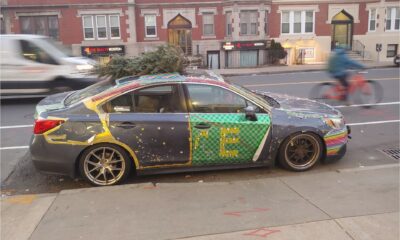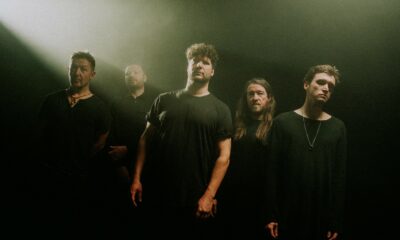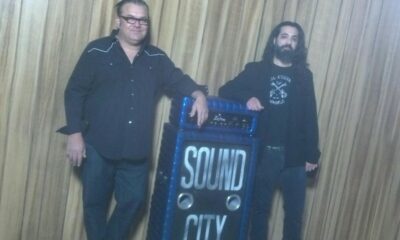Features
…And Justice For Art: A Conversation with Designer Dusty Peterson
Dusty Peterson is one of those illustrators who really enjoys talking about their work. His level of enthusiasm is evident, especially when giving detailed explanations of his creative process, his technique, and the pieces of which he’s most proud. Even though to date this Seattle-based designer has produced artworks for Metal giants the likes of Six Feet Under, Bloodbath, and Cattle Decapitation, he still keeps exploring new creative paths that help him to become a more refined artist. PureGrainAudio recently had the opportunity to delve into Peterson’s mind and learn about his influences, sources of inspiration, the mechanics behind his creativity, and his overall experience working in the world of extreme music.
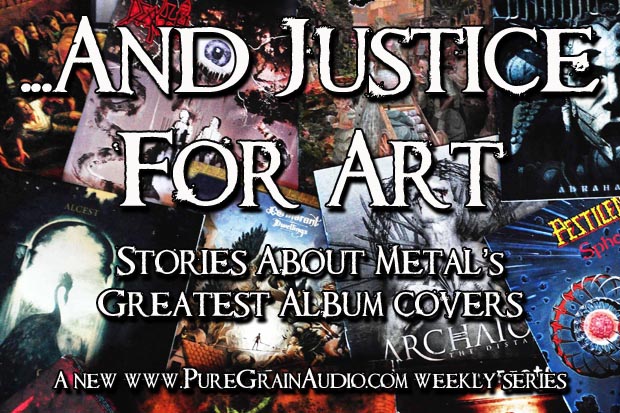
Dusty Peterson is one of those illustrators who really enjoys talking about their work. His level of enthusiasm is evident, especially when giving detailed explanations of his creative process, his technique, and the pieces of which he’s most proud. Even though to date this Seattle-based designer has produced artworks for Metal giants the likes of Six Feet Under, Bloodbath, and Cattle Decapitation, he still keeps exploring new creative paths that help him to become a more refined artist. PureGrainAudio recently had the opportunity to delve into Peterson’s mind and learn about his influences, sources of inspiration, the mechanics behind his creativity, and his overall experience working in the world of extreme music.
How did you get interested in visual arts?
Dusty: I’ve been interested in art since as long as I remember. As a kid I had a deep interest cool looking monsters. I probably blame Star Wars, He-man, and Thundarr the Barbarian for that. That interest kept going all the way into my teens when I started discovering various art books, novels, and RPG manuals that had cool art in them. For Christmas in 1993, I asked for (the book) “The Art of Michael Whelan” from my parents (I was age 14) and I never looked back. I knew at that point that I wanted to make art my life.
Did you ever have formal training?
Dusty: I did go to art school for Industrial Design Technology (a broad term that covers many areas of design – usually products, cars, toys, furniture, etc. Basically anything that you purchase that needs to be created by someone), but most of my drawing and painting skills are self-taught.
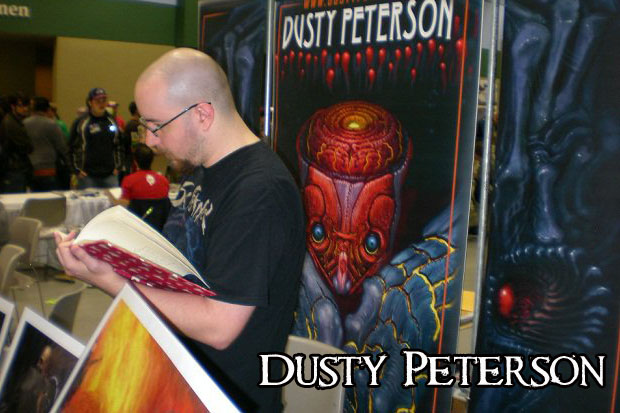
When and how did you become involved making covers and music packaging? What kind of visual projects dd you do before that?
Dusty: I did one of those “design our album cover” contests. In general, most artists and designers see them as kind of a plague on the art world as they allow a client to essentially get a lot of free ideas at no expense to themselves and then pick the best. I agree with that assessment, but honestly at that time (2006-7), I was working so hard at my day job that I just needed something – anything – to force me to do some artwork at home. I was very unhappy at my job and I wanted something different. I saw the contest for Bloodbath to design their EP (Unblessing the Purity) and I thought it sounded like fun. So I wrote them and it kind of gave me some insight on how the artist/client relationship works with these types of bands.
At the end of it they did choose my art for the cover and ended up hiring me for their follow-up LP (The Fathomless Mastery) as a proper freelance gig. So even though the contest set up by the label was maybe a little shady, the band itself was super cool and respectful to the work I was making for them. After that, I had so much fun, I figured I would seek out more work with other bands and the rest is history. Before that (and currently) I make environments for video games. I’ve worked in this industry for about 13 years now and have worked at places like Treyarch and Monolith Productions.
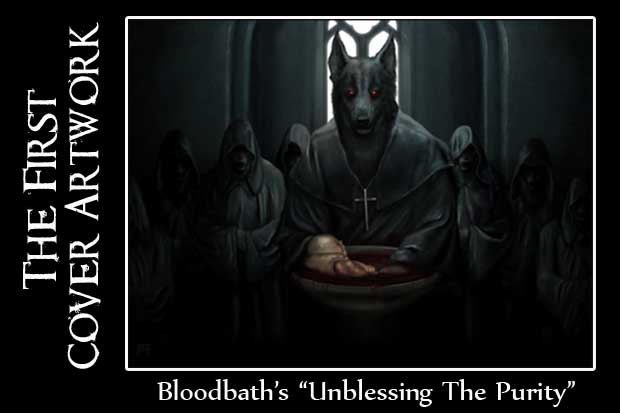
In general, your work seems like a mix of several techniques and styles, especially digital. Can you offer more details about it?
Dusty: It’s mostly digital with hints of traditional thrown into the mix. My style is basically whatever I need to complete the vision that I have for the project. I will start with a sketch (either on paper or using the Wacom tablet directly into Photoshop depending on my mood) and then rough in colors. I start with a layer underneath the sketch layer, getting flat colors in and then building up basic highlights and shadows. Once I have enough information there for me to move forward, I will flatten the sketch layer down onto the color layer and begin painting details on top of it all as one layer. I typically do not work in many layers as I try to keep the digital painting style somewhat “pure” in the sense that if I mess up, I just paint over it again and again until I am happy with it.
This simulates real paint as best as I think I can without using programs such as Painter or Art Rage (which I do also use from time to time in some cases). If I am not feeling very confident with something, I will occasionally duplicate the layer and paint on top of that, that way I can go back to a previous point easily, but I do try to stay as “painterly” as possible with my work. Occasionally, I will also start in Watercolor or Acrylic to get some basic “happy accidents” down that I can use as a basis. It just depends on how precise I want to be with it. Sometimes I like it to flow a little more organically (in cases like my recent Six Feet Under work) and so I prefer a traditional paint sketch to start it up.
Can you tell me more about your creative process. What’s your main source of inspiration?
Dusty: Depending on what I am making, it can be quite different. Sometimes, I just riff on years of watching horror movies, reading comics, and studying animal/insect biology. That is to say, I don’t think about it at all – I just draw and hope it comes out alright in the end. But other times I will deeply research subtleties in ways people would more than likely never get on their own. Both ways are satisfying to me. At this point, my main source of inspiration has to be my wife. While there are thematic elements that keep me interested in the kind of art that I do, she keeps me going. She’s always there to get me through the hard parts. And honestly, I’m not a super hero. I struggle with my art just like anyone. I have times where I just want to stop what I am doing and trash it and she helps me through it.
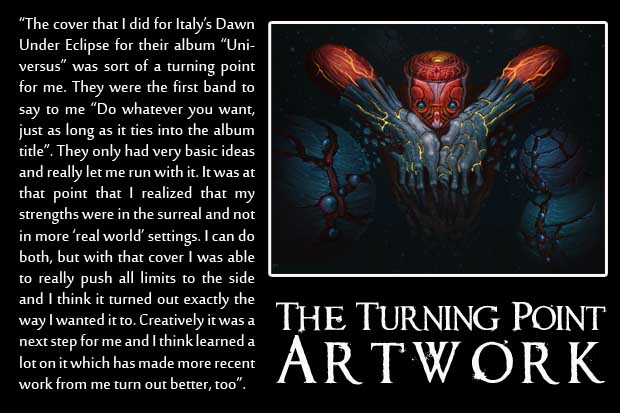
Do you remember the first album cover you created and how felt about it?
Dusty: The Bloodbath EP was my first one (as I mentioned above), but I didn’t have a whole lot of stress about it because it was over the course of a couple of months and there was no time limit. I just remember saying to myself, “This MUST be badass. This MUST be badass”, haha. After all, the most memorable Death Metal album covers always have that aspect to them. I was (and am) a huge Metal fan, so it was important to me to do the best I could. It still is, of course, but being that that was the first one I ever did I think I thought about it a lot more. Now I go more for a more methodical approach on what I think is necessary for the project. It’s less “MUST BE BADASS” and more “What is this supposed to convey?”
By now your style and way of brushing has become very recognizable. It’s easy to notice some of your trademarks, the communion between the organic and the fantastic, between the horrific and the beautiful. In your opinion is there a fully developed “Dusty Peterson style” already or is there always space to improve?
Dusty: Thank you! I have a hard time analyzing my own art. I acknowledge that there are techniques that I utilize, in one way or another, in all of my pieces but I can never quite tell if that is my “style” or not. I definitely do NOT believe I am fully developed. I’m always learning, always digging deeper into the theory aspect of creating art and trying to improve upon my color and composition. I actually think that at this point in my artistic career I am quite young and inexperienced. It’s my goal to always push it forward, though!
You’ve worked with some important Metal bands such as SFU, Bloodbath, Oceano, and Cattle Decapitation. Which was in your opinion, your breakthrough album cover?
Dusty: Six Feet Under’s Graveyard Classics 3. This was my first work for SFU and my first major label client after Bloodbath. It was the point where I realized that none of this was a fluke and that I could work in this field without a contest being the reason for it. It gave me the confidence to say that this is an industry that I can be a part of. It also didn’t hurt that I listened to Cannibal Corpse as a teenager and never thought in a decade from that point I’d be doing artwork for their old vocalist.
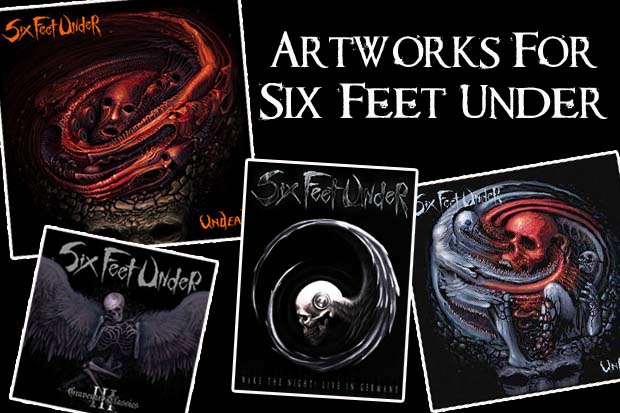
Then it must be surreal for you to have established a long lasting professional relationship with SFU. Vocalist Chris Barnes has said many great things about you and your work. How important has this particular collaboration been for your career, especially in the music business?
Dusty: As candid as I can possibly be, Chris Barnes is one of the coolest guys that I’ve ever worked with. We have a fantastic working relationship. The fact is that I do have a day time job that soaks up a lot of my time, so I am not able to be as aggressive in getting new clients as I would like. So to have a band like Six Feet Under who is so easy to work with really makes it possible for me to even do this at all so that is very important.
So, it’s easier to work with him than with other, less experienced bands?
Dusty: There are a lot of challenges with working with less experienced bands at times (lots of back and forth, financial issues, edits, and just overall communication issues) and Chris is friendly, professional, and he calls me often for work! So I can’t complain in the least bit. I’ve had great clients and even a couple horrible ones, but the mystery on how a new client will be is always a little scary. With Chris, I know exactly how it’s going to go down and that is completely invaluable.
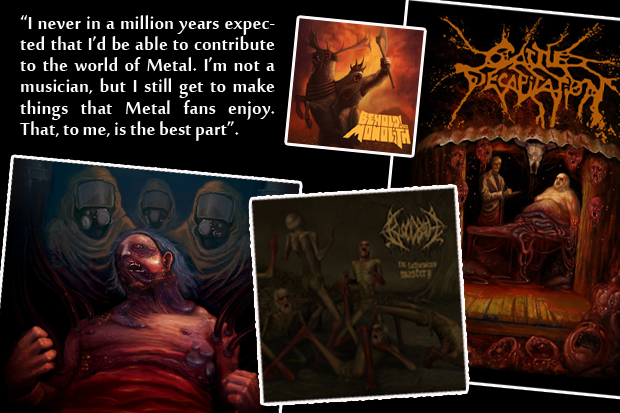
Which would you say are your main influences as an artist?
Dusty: First and foremost is Michael Whelan. He was the first artist that I saw that basically did it all. He can do the really gnarly, surreal monsters (see his Sepultura and Obituary covers) and he can also do amazing sci-fi vistas. His covers for Stephen King’s Dark Tower books are just legendary. And that is the tiniest tip of the iceberg. He’s just disgustingly good.
Second would be Wayne D. Barlowe. He’s probably most known for his “A-Z of Extraterrestrials” book where he took characters from popular science fiction and made an encyclopedia of them. But he’s done a lot of amazing stuff like his “Barlowe’s Inferno” book and “Expedition”. Of all of my favorite artists, I feel like I have stolen his style the most. I’m just being honest! I love everything he does and you can see his style all over my artistic DNA.
Finally, and I’m sure he’s everyone’s favorite, but HR Giger was the first guy where I said to myself “Really? You can just get paid to make monsters?”. Obviously, his body of work goes a lot deeper than simply designing “Alien,” but his approach to dark surreal art will always stick with me.
In your opinion, what attributes make a cover artwork successful both in visual and practical terms?
Dusty: I think a metal album covers need to have something to it that makes the person buying it say “Wow. Now that’s an album cover. That’s what I believe METAL is all about.” I love variety and I won’t speak ill of the “Black Albums” of the world because they have their place, but I never care about or remember gimmick covers. I like ones where you know the artist toiled away on it for months. I like that personal touch that tells you both the band and the artist that made it give a shit. I don’t like covers that seem like they were fashioned from a board meeting at the label. I don’t like covers that seem like they are designed to trick people like “Make it red! Red will stick out on the shelf!”
That said, in this day and age I think everyone needs to come to terms with the fact that the big art-space of a vinyl record is not the primary demographic anymore. People need to make sure to make designs that look great both zoomed in (for that big high rez Blabbermouth story) and zoomed out really small (for the iPhone Thumbnail). That’s a mistake that I made early on that I think I have a better handle on now.
Are you currently working on any new projects within or outside the music industry?
Dusty: There are a few things coming up at unknown dates that I can’t talk about, but I am mostly focused on some personal art (and a book) at the moment. I am always open to hearing about new opportunities, though.
Next Time on AJFA: “The Chuck Schuldiner Reissues” – An Interview with Eric Greif
Previously on AJFA: A Look Back to (some of) Judas Priest’s Album Covers, featuring guitarist KK Downing and designers Mark Wilkinson and Pete Alander
-

 Music6 days ago
Music6 days agoTake That (w/ Olly Murs) Kick Off Four-Night Leeds Stint with Hit-Laden Spectacular [Photos]
-

 Alternative/Rock7 days ago
Alternative/Rock7 days agoThe V13 Fix #010 w/ High on Fire, NOFX, My Dying Bride and more
-

 Alternative/Rock2 weeks ago
Alternative/Rock2 weeks agoA Rejuvenated Dream State are ‘Still Dreaming’ as They Bounce Into Manchester YES [Photos]
-

 Features6 days ago
Features6 days agoTour Diary: Gen & The Degenerates Party Their Way Across America
-

 Culture1 week ago
Culture1 week agoDan Carter & George Miller Chat Foodinati Live, Heavy Metal Charities and Pre-Gig Meals
-

 Music1 week ago
Music1 week agoReclusive Producer Stumbleine Premieres Beat-Driven New Single “Cinderhaze”
-

 Alternative/Rock1 week ago
Alternative/Rock1 week agoThree Lefts and a Right Premiere Their Guitar-Driven Single “Lovulator”
-
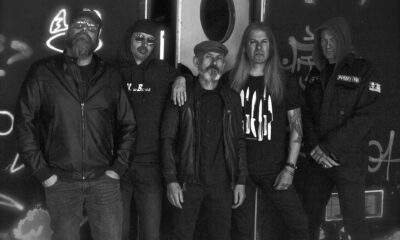
 Alternative/Rock2 weeks ago
Alternative/Rock2 weeks agoDeath Wishlist Are Fiery and Fierce with Their “I Get Bored” Video Premiere

